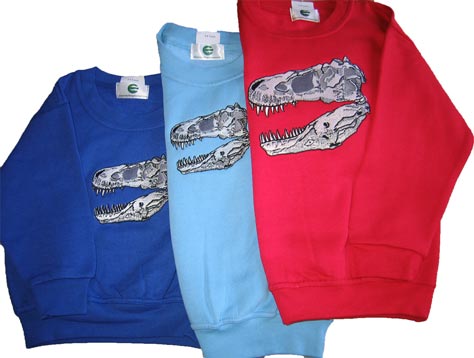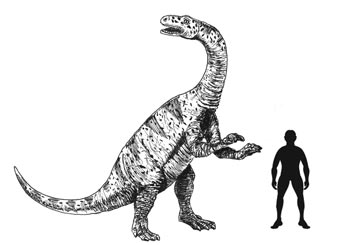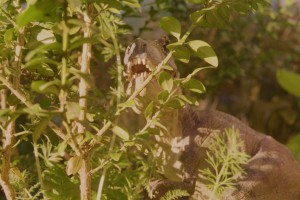Everything Dinosaur Launches First Items in Own Clothing Range
T. rex Skull Sweatshirts Now in Stock
With a roar of delight, team members at Everything Dinosaur have got their hot little mammalian hands on the first of their very own clothing range, dinosaur themed sweatshirts for children that feature a T. rex on the front. The company has been working on a number of new product ideas and it had long been an ambition to create a range of children’s clothing that featured high quality and scientifically accurate dinosaur images.
The T. rex Skull Themed Sweatshirts from Everything Dinosaur
Picture credit: Everything Dinosaur
Dinosaur Themed Sweatshirts
The super Tyrannosaurus rex skull motif on the front is based on a real fossil T. rex skull discovered in 1992 (STAN – BHI3033), to give the specimen code and each stitched design has between 20,000 – 30,000 individual stitches in it.
The sweatshirts are a 50% cotton/50% polyester weave and they were chosen as they are very good quality and match the typical sweatshirts and jumpers used in school uniforms. Available in three colours for the moment, sky blue, royal blue and red (T. rex red as we call it), the stitching work is done in England, as the team members at Everything Dinosaur wanted to support the British textiles industry.
A Range of Sizes
Three sizes have been introduced so far with an age range from 3-8 years (chest size from 26″ [66cm] to a generous 30″ [76cm]) and having fulfilled the company’s commitments to those customers who had reserved one, this new addition to Everything Dinosaur’s clothing range has now gone on general sale.
To view the range of dinosaur themed items available from Everything Dinosaur: Dinosaur Clothing – Dinosaur Themed Clothing.
A spokesperson for the company stated:
” We have been working on the introduction of our own dinosaur themed clothing range for sometime. We felt that there was a lot of poor quality and highly inaccurate dinosaur themed clothing for children out there and we wanted to do something about this. Combining the knowledge of our dinosaur experts with the product procurement team seemed the logical answer and I am delighted to see the sweatshirts now in stock.”
The Tyrannosaurus rex Skull
The Tyrannosaurus skull material on which the motif is based represents one of the most complete and best preserved T. rex skulls found to date. The fossil material was found in South Dakota (United States) and in all, about two thirds of the entire skeleton was discovered.
“We carried out research amongst our customers as to what they wanted and got feedback on choice of sweatshirts and what colours to stock,” she added. “Then once the drawings had been approved by our team, it was just a matter of trying to find a textile company that could produce such a high-quality garment based on our specifications”.
The hard work and dedication of the staff seems to have paid off, as once customers got to hear about the company’s plans Everything Dinosaur received a lot of requests to have clothing items reserved. Now that the last of the reserved clothing has been sent out, team members can focus on putting this new and unique clothing range on general sale.
T. rex Sweatshirts Include T. rex Fact Sheet
Picture credit: Everything Dinosaur
As part of Everything Dinosaur’s commitment to education, each T. rex sweatshirt is sent out with a Tyrannosaurus rex fact sheet written by the prehistoric animal experts in the company. Children get to wear a T. rex skull on their chest as well as to read all about the “King of the Tyrant Lizards”.
Staff are already working on a number of other clothing ideas, with the intention to add more items to their clothing range with “rex appeal”.





















